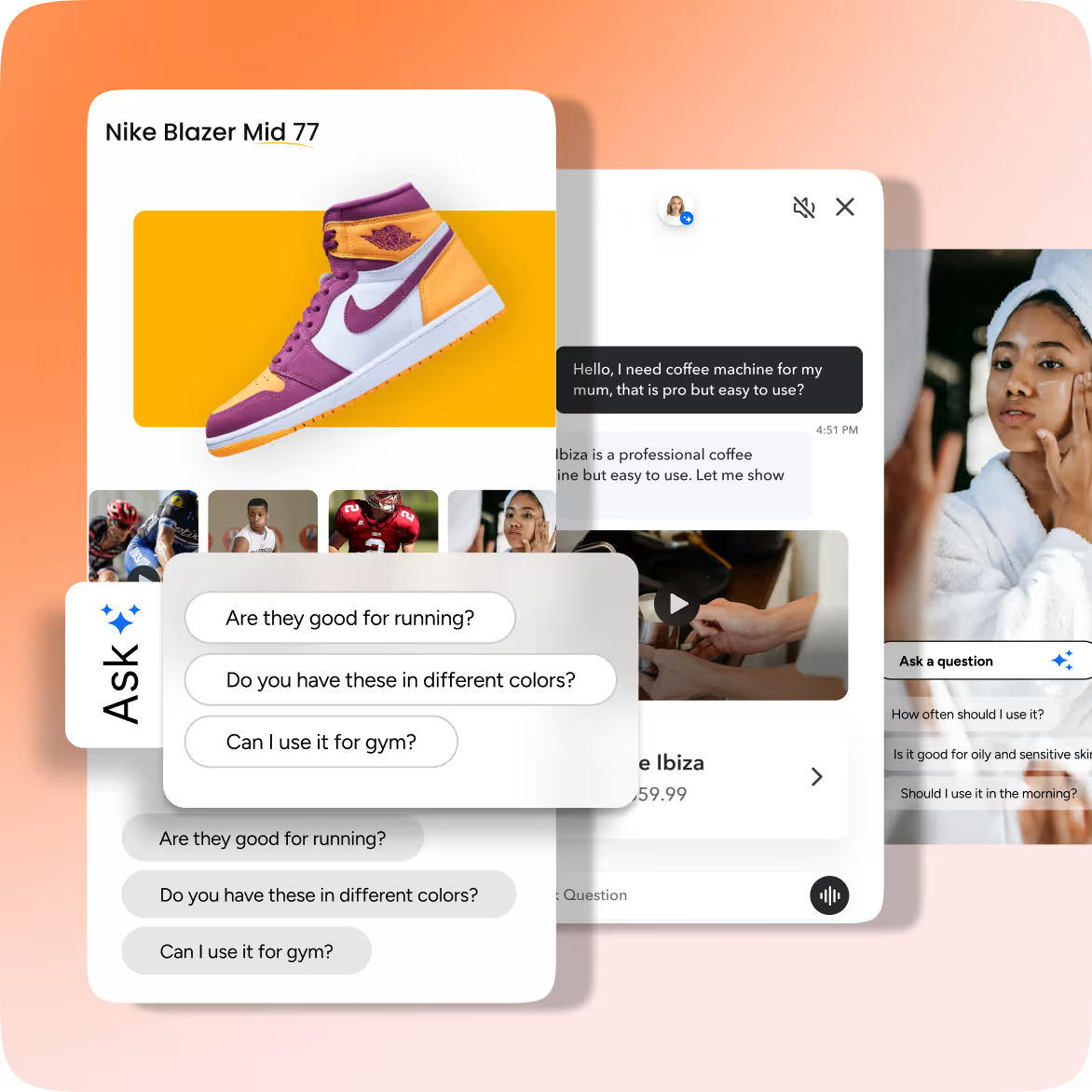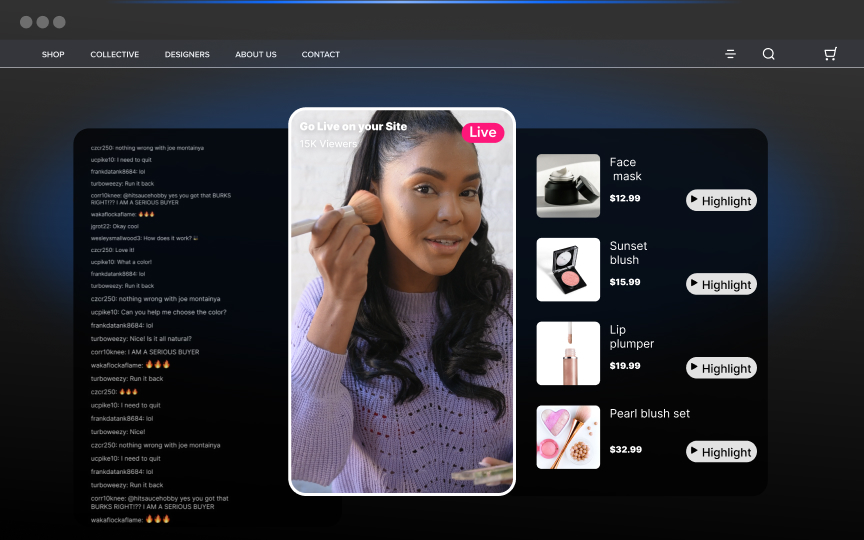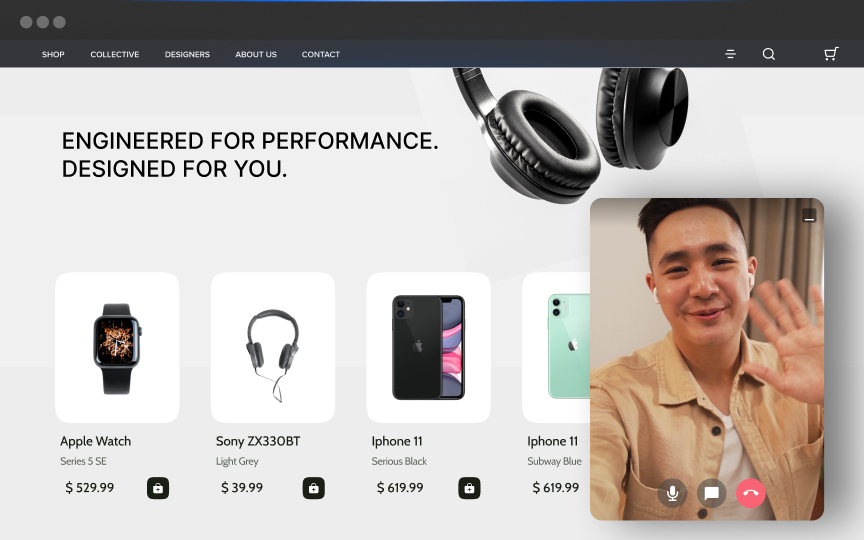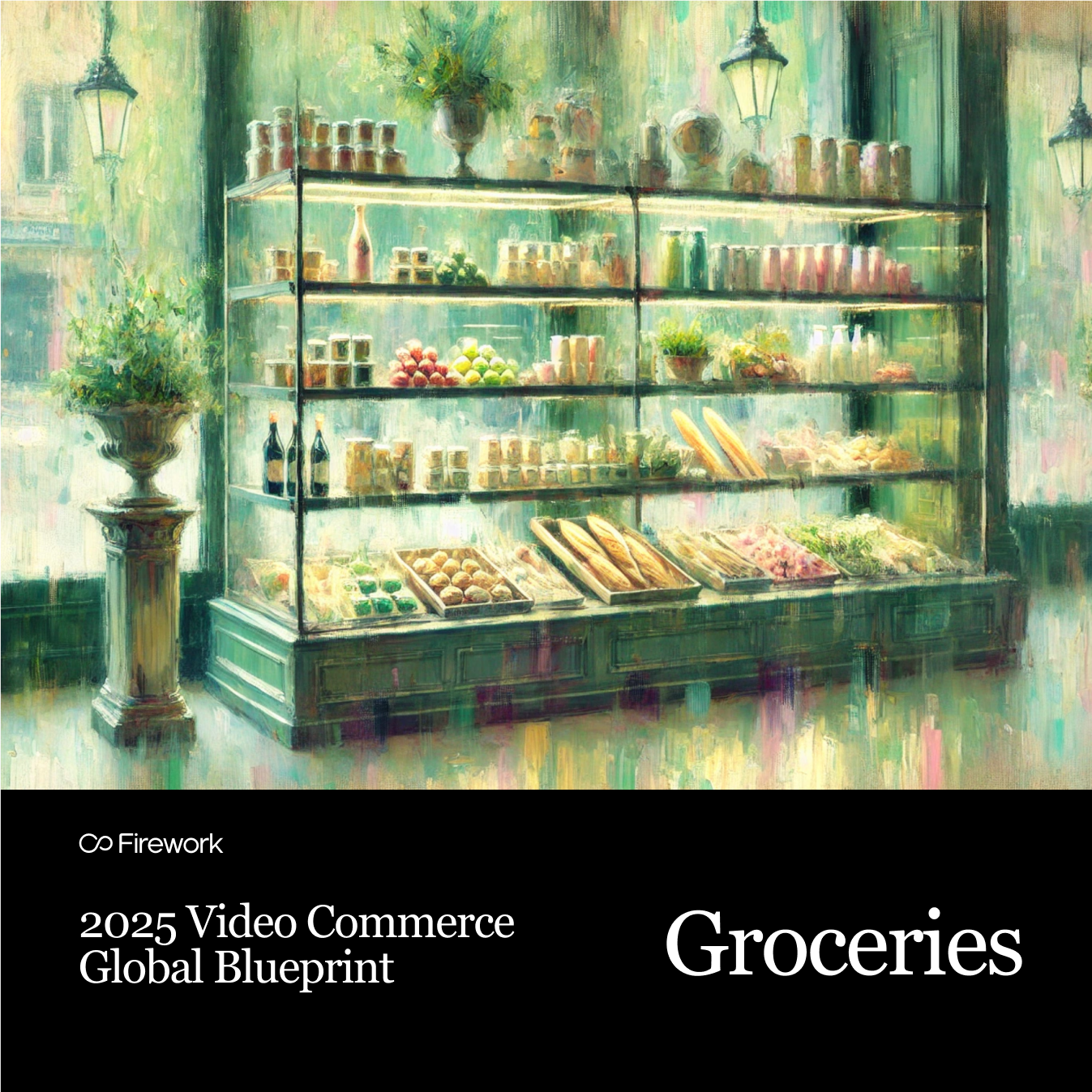Effective grocery store marketing strategies are essential for attracting customers and boosting sales. Success in this arena goes beyond flashy advertisements; it requires implementing comprehensive tactics that genuinely resonate with shoppers.
On the digital front, video commerce is revolutionizing grocery marketing. An impressive 87% of marketers in the food, beverage, and grocery sectors report increased sales through video commerce in grocery marketing. By creating engaging content that truly connects with your audience, you can significantly enhance your grocery store's success and stand out in a crowded marketplace. Keep reading to learn how you can do that:
10 Grocery Store Marketing Strategies
1. Develop a Strong Online Presence
A robust online presence is a cornerstone of effective grocery store marketing strategies. It attracts new customers and keeps loyal ones returning.
Your website, social media channels, and direct messaging platforms should work cohesively to provide seamless shopping experiences and meaningful engagement, bringing in-store experiences online.
Optimize Your Website
Your grocery store's website must be:
- Fast
- Mobile-friendly
- Easy to navigate
With most people searching on their phones, quick load times are important. Utilize relevant keywords and high-quality images to improve search engine rankings. Incorporate grocery store marketing strategies into your site's content to enhance visibility.
If you offer e-commerce, ensure the platform is intuitive—from product browsing to checkout—and consider implementing proven e-commerce success strategies.
Social Media Marketing
Platforms like Facebook, Instagram, and TikTok allow you to connect with shoppers where they spend their time. You can do the following to humanize your brand:
- Share fresh photos
- Put exclusive offers
- Post behind-the-scenes glimpses
- Encourage user-generated content in grocery marketing
Short, engaging videos can effectively showcase your products and promotions. If you're new to this, learn how to start livestreaming for your business. Utilizing grocery store marketing strategies on social media amplifies your reach and fosters a community around your store.
Leverage Live Shopping
Live shopping events create real-time excitement and encourage viewers to make immediate purchases. Before starting, consider reviewing a livestreaming checklist to ensure your campaign's success. The rise of livestream shopping has opened new avenues for retailers to engage with customers.
By enhancing customer engagement with video and turning videos into shoppable posts, you streamline the path from browsing to checkout, increasing conversion rates and boosting sales.
Email & SMS Marketing
Encourage sign-ups by offering exclusive discounts or freebies, then tailor your messages based on shopping habits and preferences.
Short, targeted updates—such as announcing new products or limited-time promotions—keep customers engaged and informed. Include direct links back to your website or store to facilitate convenient shopping.
2. Enhance In-Store Experience
Creating a welcoming in-store environment is a key aspect of effective grocery store marketing strategies. It encourages customers to linger, explore, and make purchases. Attention to detail—from store layout to interactive demonstrations—can make your store stand out from the competition.
Create a Welcoming Atmosphere
Design your store to avoid cluttered aisles that feel like obstacle courses.
- A clean, open layout naturally guides shoppers and gives them room to browse comfortably.
- Warm lighting and inviting décor contribute to a pleasant shopping experience.
- Friendly, knowledgeable staff members can make a significant difference by offering assistance and personalized recommendations, turning casual shoppers into loyal customers.
Use In-Store Advertising
Implement digital screens or interactive kiosks to display,
- Promotions
- Recipes
- Product information
Brief, looping videos can encourage shoppers to try new items or take advantage of special deals.
Offer Free Samples & Demos
A well-placed sampling station encourages interaction and boosts confidence in a purchase. Staff can highlight unique flavors, address concerns like allergens, and share creative recipe ideas, enhancing the overall shopping experience.
Seasonal & Thematic Promotions
Keep your store dynamic with events tied to holidays or local happenings. Seasonal décor and thematic displays, along with interactive workshops or contests, keep the store buzzing with activity.
Announce these promotions on social media and with prominent in-store signage to prompt impulse buys, seamlessly integrating grocery store marketing strategies into every aspect of your business.
3. Implement Loyalty & Rewards Programs
Shoppers appreciate feeling valued, and loyalty programs—especially those accessed through user-friendly apps—motivate repeat visits and provide valuable insights into buying habits.
Digital Coupons & Mobile Apps
Developing a mobile app for your store allows you to offer exclusive coupons and deals while gathering real-time data on purchasing trends. Push notifications enable you to send timely reminders about limited-time offers or new product launches.
The convenience of digital coupons, easily scanned at checkout, makes them more accessible than traditional paper versions, encouraging higher redemption rates.
Point-Based Rewards System
Implementing a points system where each purchase brings customers closer to a future reward adds an element of gamification to the shopping experience. Watching points accumulate creates excitement and motivates continued patronage.
Providing a digital dashboard where customers can easily track their points and redeem rewards enhances engagement and strengthens loyalty.
Exclusive Membership Benefits
Offering exclusive membership benefits—such as early access to sale items, special event invitations, or members-only discounts—can make customers feel valued and appreciated.
A tiered loyalty program amplifies this effect, encouraging higher spending to unlock additional rewards and privileges. ]
4. Engage with the Local Community
Local sourcing, sponsorships, and community events highlight your commitment to the area. Community engagement is a vital element of effective grocery store marketing strategies.
Partner with Local Suppliers
Featuring fresh, local produce and artisanal products resonates with shoppers who appreciate unique items and want to support hometown businesses. Collaborative efforts—like showcasing supplier stories or hosting "meet the maker" events—spark interest and build trust.
Offering items that shoppers can't find elsewhere differentiates your store from competitors.
Sponsor Community Events
Getting involved in local festivals or charity fundraisers puts your store in front of a receptive audience. You'll boost brand visibility through banners, flyers, or product sampling. More importantly, people recognize that you're invested in what matters to them, fostering goodwill and loyalty.
Organize Store Events & Workshops
Transform your grocery store into a community hub by hosting cooking classes, nutrition seminars, or DIY workshops. Invite local chefs, nutritionists, or artisans to lead these sessions, adding value for your customers. Families appreciate kid-friendly activities, and home cooks enjoy mastering new recipes. These gatherings create genuine connections and keep your store top of mind.
5. Utilize Digital & In-Store Technology
Embracing technology is one of the forward-thinking grocery store marketing strategies. It transforms the shopping experience by speeding up checkout lines, customizing offers, and keeping shoppers engaged throughout the store.
Understanding the benefits of live events versus video showrooms helps determine what fits your business needs.
Self-Checkout & Mobile Payments
Long lines are a deterrent for busy shoppers. Self-checkout stations allow customers to scan and bag their own items, while mobile payment options streamline the entire process. This convenience leads to faster store visits and increased customer satisfaction.
Personalized Shopping Experience
By analyzing past purchases, AI can suggest relevant products or pairings displayed on digital screens or through your mobile app.
This personalized attention enhances the shopping experience and boosts sales potential. Customers appreciate product suggestions that feel uniquely tailored to them.
In-Store Music & Messaging
Sound and visual cues significantly influence a shopper's mood. Curate a music playlist that complements your store's atmosphere while well-placed digital signage reinforces promotions, features recipes, or highlights new arrivals.
Incorporating engaging interactive video content into your store setting can enrich the customer experience as part of your grocery store marketing strategies.
6. Influencer & Customer Engagement Strategies
Collaborating with content creators and encouraging customers to champion your store expands your reach beyond traditional advertising, especially when engaging Gen-Z customers.
Collaborate with Local Influencers
Partnering with influencers who live nearby or align with your brand values can attract shoppers who trust their recommendations. Collaborations might include:
- Hosting events
- Featuring products in their content
- Offering exclusive giveaways
For example, local fitness influencers promoting healthy products can make a noticeable impact on sales and brand awareness.
Encourage User-Generated Content
Invite customers to share their own photos, videos, or reviews of your store and products. Feature memorable submissions on your official pages to build a sense of community and encourage more participation.
User-generated content not only boosts brand loyalty but also provides authentic testimonials that resonate with potential customers.
Referral Programs
Word-of-mouth remains a powerful driver of sales. Offer discounts or perks to customers who refer friends and family. It's a win-win—the new shopper discovers your store, and the referrer receives a reward.
Simplify sharing by providing referral codes that can be easily shared via social media or direct messaging, enabling customers to spread the word quickly.
7. Data-Driven Marketing & Analytics
Analyzing data reveals which approaches are effective and which need adjustment. Clear insights into customer behavior help you refine tactics and optimize your marketing efforts.
Monitor Sales & Customer Behavior
Real-time analytics allow you to see:
- How often products are viewed online
- How long do shoppers stay on a page
- Which aisles receive the most foot traffic
Use these insights to tweak displays, adjust stock levels, or personalize marketing campaigns.
Cloud-based platforms store vast amounts of data, making it easier to spot trends and plan smarter promotions.
A/B Testing for Promotions
Small changes can make a significant difference in response rates. Test different versions of an advertisement—such as a new headline or image—and analyze which one drives more engagement or sales. These measurable results indicate what resonates best with your audience, allowing you to refine your marketing strategies.
Use Geo-Targeting
Geo-targeting tailors ads to people in specific locations. Promote local deals or events to encourage foot traffic from those in nearby neighborhoods. Combining location-based efforts with data from sales monitoring or A/B testing helps you reach the right shoppers at the right time, maximizing the effectiveness of your marketing campaigns.
8. Offer Delivery & Subscription Services
Adapting to consumer needs is a vital part of effective grocery store marketing strategies. Offering convenient delivery and subscription options meets customers where they are and enhances satisfaction.
Grocery Delivery Integration
Integrate with third-party delivery services like Instacart or DoorDash to expand your customer base.
Providing delivery tracking, flexible drop-off times, and direct-to-consumer channels allows shoppers to handle grocery runs from home. Maintaining brand consistency throughout the delivery process ensures a positive customer experience that reflects well on your store.
Subscription Boxes & Meal Kits
Subscription boxes and meal kits cater to convenience-driven shoppers seeking easy meal solutions. Pre-portioned ingredients reduce prep time and simplify grocery lists. Pair this offering with engaging video content to demonstrate how easy cooking can be, boosting brand engagement and differentiating your store from competitors.
9. Adopt Traditional Marketing Strategies
While digital methods are essential, traditional marketing still plays a vital role in effective grocery store marketing strategies. These methods reach audiences who appreciate tangible promotions.
Print Advertising
Weekly flyers or mail-in circulars still resonate with many shoppers. Physical advertisements help people spot deals they might otherwise miss and often remain visible on kitchen counters as reminders. In-store magazines featuring recipes and cooking tips can reinforce your brand's identity and provide added value to customers.
Billboards & Outdoor Advertising
Strategically placed billboards in high-traffic areas draw attention to special sales or promotions. A memorable design or catchy message leaves a quick yet lasting impression.
Incorporating QR codes on billboards can lead smartphone users directly to an online coupon or weekly ad, seamlessly connecting offline advertising with online engagement.
Community-Based Discounts
Offering discounts tied to community events or organizations demonstrates your investment in local customers. Provide group deals to schools, local clubs, or non-profit organizations, and maintain a presence at their gatherings. This personal touch nurtures goodwill and encourages shoppers to choose your store for their grocery needs.
10. Sustainability & Eco-Friendly Initiatives
Incorporating sustainability into your grocery store marketing strategies can set your store apart and appeal to environmentally conscious consumers.
Eco-Friendly Packaging
Reducing plastic use and offering biodegradable packaging options appeal to shoppers concerned about environmental impact. Packaging made from recycled materials or plant-based resources helps cut waste and demonstrates your commitment to sustainability. Even small steps—like minimizing excess wrapping—signal that your store is taking responsible actions.
Zero-Waste Programs
Implementing zero-waste programs keeps waste out of landfills and encourages responsible consumer behavior. Take-back initiatives allow customers to return packaging for recycling or composting. Rewarding participation through discounts or loyalty points can inspire a culture of reusing and recycling within your customer base.
Energy-Efficient Practices
Upgrading to LED lighting, installing energy-efficient refrigeration units, and utilizing smart HVAC systems reduce energy consumption. Investing in renewable energy sources like solar panels further lessens your carbon footprint. Beyond cost savings, these initiatives demonstrate a commitment to environmental stewardship, resonating with eco-conscious shoppers.
Final Words
A balanced, thoughtful approach to grocery store marketing strategies can transform your store's performance.
Equally important are hands-on efforts: local partnerships, in-store events, and printed promotions reach customers who appreciate a personal touch. Incorporating sustainable practices earns trust from eco-conscious consumers and sets your store apart.
Successful grocery stores adapt to changing expectations by combining creativity, technology, and a genuine commitment to the communities they serve, ensuring long-term growth and customer loyalty.
Put your commerce in motion. Find out how Firework can power your business forward by visiting Firework.
FAQs
What is the marketing strategy of a supermarket?
The marketing strategy of a supermarket focuses on competitive pricing, promotions, loyalty programs, and in-store experience. It also includes digital marketing, seasonal discounts, and product placement tactics to boost sales.
What are the 4 main marketing strategies?
The four main marketing strategies are product, price, place, and promotion (the 4Ps). These strategies help businesses position their offerings, attract customers, and maximize revenue through effective branding and outreach.
How do grocery stores attract customers?
Grocery stores attract customers through discounts, loyalty programs, in-store samples, strategic product placement, and digital promotions. Fresh produce, cleanliness, and convenience also play a major role in drawing shoppers.
How do I market my small grocery store?
To market your small grocery store, use local SEO, social media, flyers, discounts, and loyalty programs. Partner with local suppliers, offer home delivery, and create a welcoming shopping experience to retain customers.
Unlock Exclusive Insights
By submitting this form, you agree to Firework's privacy policy and consent to receive personalized marketing communications. You can unsubscribe at any time.






























